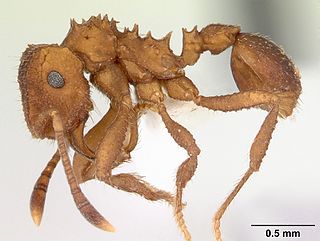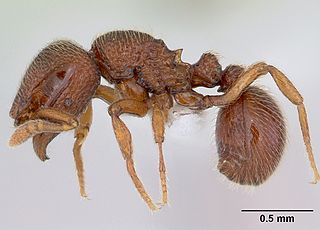
Myrmicinae is a subfamily of ants, with about 140 extant genera; their distribution is cosmopolitan. The pupae lack cocoons. Some species retain a functional sting. The petioles of Myrmicinae consist of two nodes. The nests are permanent and in soil, rotting wood, under stones, or in trees.

Ant–fungus mutualism is a symbiosis seen between certain ant and fungal species, in which ants actively cultivate fungus much like humans farm crops as a food source. There is only evidence of two instances in which this form of agriculture evolved in ants resulting in a dependence on fungi for food. These instances were the attine ants and some ants that are part of the Megalomyrmex genus. In some species, the ants and fungi are dependent on each other for survival. This type of codependency is prevalent among herbivores who rely on plant material for nutrition. The fungus’ ability to convert the plant material into a food source accessible to their host makes them the ideal partner. The leafcutter ant is a well-known example of this symbiosis. Leafcutter ants species can be found in southern South America up to the United States. However, ants are not the only ground-dwelling arthropods which have developed symbioses with fungi. A similar mutualism with fungi is also noted in termites within the subfamily Macrotermitinae which are widely distributed throughout the Old World tropics with the highest diversity in Africa.

Sericomyrmex is a genus of fungus-growing ants in the subfamily Myrmicinae.

Acropyga is a genus of small formicine ants. Some species can be indirect pests. A. acutiventris, which is found from India to Australia, tends subterranean, root-feeding mealybugs of the species Xenococcus annandalei. Living, gravid females are carried in the jaws of A. acutiventris queens during their nuptial flight, to establish the symbiotic association in founding colonies. Other Acropyga species have relationships with different species of mealybugs, and it could be a trait common to the whole genus.

Mycocepurus is a Neotropical genus of fungus-growing ants in the subfamily Myrmicinae. The genus is known from Mexico, south to Brazil and Argentina. Like other attines, they primarily grow fungi of the tribe Leucocoprini. They use many different substrates for growing their fungi, from dry leaves and caterpillar dung to fruit matter. One of its species, Mycocepurus smithii, which lives in South America, reproduces by cloning – all ants in a colony are clones of the queen. M. castrator is a parasite of M. goeldii.

Kalathomyrmex is a genus of ant in the subfamily Myrmicinae containing the single species Kalathomyrmex emeryi. First described as Myrmicocrypta emeryi by Forel in 1907, the species was most recently moved to its current genus by Klingenberg and Brandao in 2009.

Myrmecina is a genus of ants in the subfamily Myrmicinae. It contains 53 species distributed in North America, Europe, northern Africa, India, Korea, Japan and Australia.

Atta mexicana is a species of leaf-cutter ant, a New World ant of the subfamily Myrmicinae of the genus Atta. This species is from one of the two genera of advanced attines within the tribe Attini.

Trachymyrmex is a genus of fungus-growing ants in the subfamily Myrmicinae. The genus is mainly tropical in distribution, with most species being found in Central and South America.

Myrmicocrypta is a Neotropical genus of fungus-growing ants in the subfamily Myrmicinae. The genus is known from Mexico to Argentina. Their colonies are generally small, consisting of fewer than 200 individuals.

Cyphomyrmex is a genus of fungus-growing ants found primarily in South and Central America. However, some species do come up to the southern portion of North America. They grow a variety of fungi in the tribe Leucocoprineae. Most fungal gardens are grown in small nodules, some species to cultivate entire mycelium, though. Colonies are monogynous and are relatively small with about 100 workers on average.

Eutetramorium is a small genus of ants within the subfamily Myrmicinae. To date it contains three species found in Madagascar and Comoros.

Paramycetophylax is a genus of fungus-growing ants in the subfamily Myrmicinae. It contains the single species Paramycetophylax bruchi, known only from Argentina. Workers collect leaflets from Prosopis flexuosa that they bring back to the nest to act as substrate for the fungus.

Dicroaspis is an African genus of ants in the subfamily Myrmicinae.

Stenamma is a genus of cryptic leaf-litter ants that occurs in mesic forest habitats throughout the Holarctic region, Central America, and part of northwestern South America.
Megalomyrmex mondabora is a Neotropical species of ants in the subfamily Myrmicinae. Known from Costa Rica. In Costa Rica this species occurs in wet forest habitats, typically in mature rainforest. Collections are from sea level to 800 m elevation on the Atlantic slope of the Cordillera Volcanica Central, Cordillera de Talamanca, and Cordillera de Guanacaste. It is a specialized nest parasite of attines and is found most often in nests of Cyphomyrmex cornutus. It cohabits with C. cornutus in their nests, feeding on both host brood and the host's fungal symbiont.
Megalomyrmex mondaboroides is a Neotropical species of ant in the subfamily Myrmicinae. Megalomyrmex mondaboroides occurs in lowland wet forest habitats in Panama and Costa Rica. Colonies have been collected in the nests of small attines, primarily Cyphomyrmex costatus and Apterostigma goniodes. In Costa Rica a worker was collected in a Winkler sample of sifted leaf litter.
Megalomyrmex adamsae is a Neotropical species of ants in the subfamily Myrmicinae. Megalomyrmex adamsae, known from Panama, is very similar to M. symmetochus, known from Costa Rica to Panama.
Megalomyrmex wettereri is a Neotropical species of ants in the subfamily Myrmicinae. Megalomyrmex wettereri is known from two lowland rainforest sites: Barro Colorado Island in Panama and La Selva Biological Station in Costa Rica.















